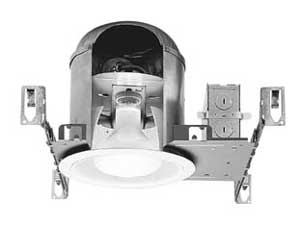SceneryDriver
Senior Member
- Location
- NJ
- Occupation
- Electrical and Automation Designer
I just had a thought regarding can lights - specifically new work can lights - and their junction boxes. How does the code reconcile the junction box placement on those cans with the fact that junction boxes must remain accessible? I'm thinking of lights like this:
http://www.residential-landscape-lighting-design.com/store/images/HALO_H27ICT.jpg
I can think of plenty of cans with j-boxes I can't service without tearing out drywall. Why is that OK? I can't bury a 4" j-box in the ceiling, after all. Are these cans built to supposedly be able to remove the can to gain access? I just don't see that happening in the real world.
SceneryDriver
http://www.residential-landscape-lighting-design.com/store/images/HALO_H27ICT.jpg
I can think of plenty of cans with j-boxes I can't service without tearing out drywall. Why is that OK? I can't bury a 4" j-box in the ceiling, after all. Are these cans built to supposedly be able to remove the can to gain access? I just don't see that happening in the real world.
SceneryDriver


